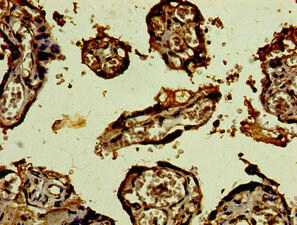Description
| Antibody Name: | CST9L Antibody (PACO40402) |
| Antibody SKU: | PACO40402 |
| Size: | 50ug |
| Host Species: | Rabbit |
| Tested Applications: | ELISA, IHC |
| Recommended Dilutions: | ELISA:1:2000-1:10000, IHC:1:20-1:200 |
| Species Reactivity: | Human |
| Immunogen: | Recombinant Human Cystatin-9-like protein (29-147AA) |
| Form: | Liquid |
| Storage Buffer: | Preservative: 0.03% Proclin 300 Constituents: 50% Glycerol, 0.01M PBS, PH 7.4 |
| Purification Method: | >95%, Protein G purified |
| Clonality: | Polyclonal |
| Isotype: | IgG |
| Conjugate: | Non-conjugated |
 | Immunohistochemistry of paraffin-embedded human placenta tissue using PACO40402 at dilution of 1:100. |
| Synonyms: | Cystatin-9-like (Testatin), CST9L, CTES7B |
| UniProt Protein Function: | CST9L: The cystatin superfamily encompasses proteins that contain multiple cystatin-like sequences. Some of the members are active cysteine protease inhibitors, while others have lost or perhaps never acquired this inhibitory activity. There are three inhibitory families in the superfamily, including the type 1 cystatins (stefins), type 2 cystatins and the kininogens. The type 2 cystatin proteins are a class of cysteine proteinase inhibitors found in a variety of human fluids and secretions. The cystatin locus on chromosome 20 contains the majority of the type 2 cystatin genes and pseudogenes. This gene is located in the cystatin locus and encodes a protein similar to mouse cystatin 9. Based on its testis-specific expression, it is likely to have a role in tissue reorganization during early testis development. [provided by RefSeq, Jul 2008]Protein type: Secreted; Secreted, signal peptideChromosomal Location of Human Ortholog: 20p11.21Cellular Component: extracellular regionMolecular Function: cysteine protease inhibitor activity |
| UniProt Protein Details: | |
| NCBI Summary: | The cystatin superfamily encompasses proteins that contain multiple cystatin-like sequences. Some of the members are active cysteine protease inhibitors, while others have lost or perhaps never acquired this inhibitory activity. There are three inhibitory families in the superfamily, including the type 1 cystatins (stefins), type 2 cystatins and the kininogens. The type 2 cystatin proteins are a class of cysteine proteinase inhibitors found in a variety of human fluids and secretions. The cystatin locus on chromosome 20 contains the majority of the type 2 cystatin genes and pseudogenes. This gene is located in the cystatin locus and encodes a protein similar to mouse cystatin 9. Based on its testis-specific expression, it is likely to have a role in tissue reorganization during early testis development. [provided by RefSeq, Jul 2008] |
| UniProt Code: | Q9H4G1 |
| NCBI GenInfo Identifier: | 18104940 |
| NCBI Gene ID: | 128821 |
| NCBI Accession: | NP_542177.1 |
| UniProt Secondary Accession: | Q9H4G1,B2R5A1 |
| UniProt Related Accession: | Q9H4G1 |
| Molecular Weight: | 17,276 Da |
| NCBI Full Name: | cystatin-9-like |
| NCBI Synonym Full Names: | cystatin 9-like |
| NCBI Official Symbol: | CST9L |
| NCBI Official Synonym Symbols: | CTES7B; bA218C14.1 |
| NCBI Protein Information: | cystatin-9-like; testatin |
| UniProt Protein Name: | Cystatin-9-like |
| UniProt Synonym Protein Names: | |
| Protein Family: | Cystatin |
| UniProt Gene Name: | CST9L |
| UniProt Entry Name: | CST9L_HUMAN |






